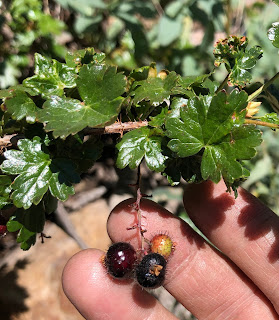 |
| Ribes lacustre |
Welcome to Mountain Edibles
I have been wandering the mountains of Utah as an amateur botanist for many years, and I am now trying to share some of what I have learned with those around me. I am a user of many edible and medicinal plants, and I believe the edible plants are the least known area of my expertise. This blog is a way to increase the popular knowledge of edible plants.
I also do plant walks to teach about edible and medicinal plants in person. If you are in the Northern Utah area, and are interested in arranging such a presentation, you can contact me using the contact form at the bottom of the page.
Thank you for coming.
Thursday, August 26, 2021
Ribes lacustre
Friday, August 6, 2021
Amaranthus retroflexus
Amaranthus retroflexus is, depending on which sources you believe, either a highly toxic plant, or a highly nutritious plant and a staple of some traditional diets. The "toxic" sources seem to prefer the common name "redroot pigweed", while the "nutritious" sources just call it amaranth. Which are you going to believe? Obviously, I'm biased towards the "nutritious" side, but it's possible that they could both be true.
I notice that most of the "toxic" sources are from agricultural sources, and report toxicity to cattle, pigs, and even goats. Amaranth is known to be able concentrate nitrates in its leaves, and in areas where there is heavy usage of chemical fertilizers which have high levels of nitrates, amaranth may have high levels of nitrates. For this reason, I would recommend against collecting your amaranth from the borders of agricultural fields. My own garden, where Amaranthus retroflexus comes up every year voluntarily, does not get these kinds of chemical fertilizers, so I'm not at risk for that type of toxicity.
Amaranth is well known for its edible seeds, which are often used similarly to grains. I have not tried collecting the seeds yet.
The leaves are commonly used as a potherb. While they can be eaten raw, I find them to be rather tough. I don't like the leaves raw much at all, but as a potherb, it is one of the best I have tasted. Boiling them for 5 minutes makes them tender, and also improves the flavor, which is like a mild spinach. Young stems (if they are still flexible) can also be eaten, and soften up nicely from the boiling. Mainly you want stems which have not formed seed clusters yet. The plants I pick often have small clusters starting to form, but I just break those off and throw them away. The small prickly bracts in those clusters do not soften when boiled, so you would want to avoid including those clusters in your pot, but if a bract or two remains from the base of the cluster, they are hardly noticeable.
